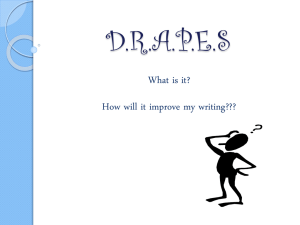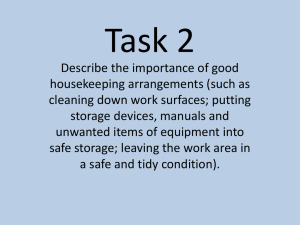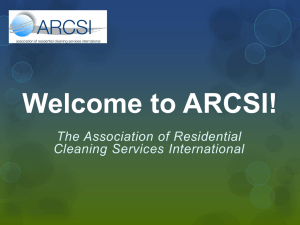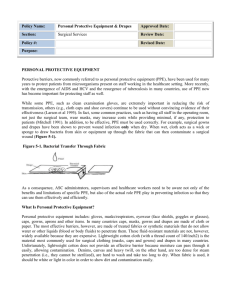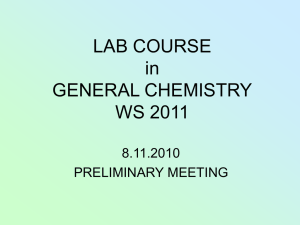Drapery Cleaning 746KB Jul 20 2010
advertisement
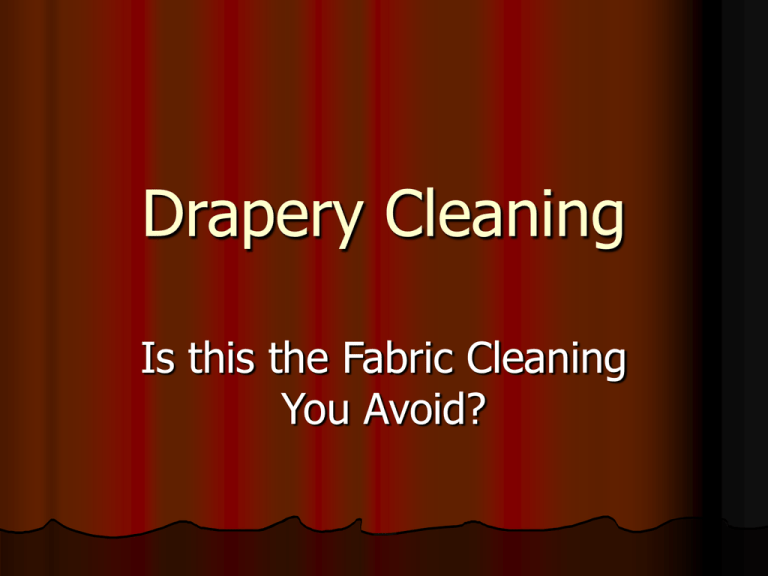
Drapery Cleaning Is this the Fabric Cleaning You Avoid? This presentation covers the basics of drapery cleaning. It is not a substitute for classroom training and hands-on experience. Drapery Cleaning Choices 1. Dry cleaners 1. 2. 3. 4. 5. 6. Take down drapes Transport to dry cleaners Wait 3 – 7 days Put up with possible damage from tumbling and handling Return and pick-up drapes, Try to get them home without wrinkles Attempt to hang drapes the way they were Drapery Cleaning Choices 2. On-location cleaning 1. No “fish bowl” feeling with neighbors looking in 2. Cleaning finished in one day 3. Drapes are never removed so they are hung the same way they were 4. Greatly reduced chance of tears, rips and other damage Drapery Cleaning Choices 3. Hire a decorator, buy new drapes Companies who promote drapery cleaning, Coit for example, do millions of dollars in on-location drapery cleaning every year. ? Why is drapery cleaning such a small or non-existent part of most cleaner’s business? Fear and uncertainty Perception that special expensive equipment is required Terminology Valance Header Panel – Fabric covering at the top of the window that hangs from the drapery rod. It may or may not cover the tops of the drapes. – The top portion of the drape where the pleat is made. The header is stiffened with a material called buckram. – One section of drape usually containing 7 pleats. Multiple panels may be sewn together. Terminology Cornice – A window top covering upholster over a box or wooden frame. Thermal / Blackout Curtains or drapes with a latex coating on the back to prevent sunlight from entering. Tie-back – How Do Draperies Get Soiled? They don’t get walked on like carpet No one sits on drapes like upholstery Drapes are a big filter removing contaminants from the air. Air currents near windows due to temperature variations Particulates, biologicals and gases in the air Oily hand prints Dry Soil Removal Concentrate on header Compressed air Brushes Vacuum Dry cleaning sponges Spot Cleaning Option Spray apply Dry Cleaning Prespray Sprayer considerations – Viton solvent resistant seals will last longer Agitate with towel or soft brush Rinse with Furniture & Drapery Compound Use towel or extractor designed for use with solvents Wet Cleaning Option Always use wet cleaning – not solvents -for thermal / black out or latex backed drapes. Solvents and / or heat will damage rubber backing Rubber may flake off due to previous damage from sunlight or cleaning. Wet cleaning can be used on many other drapes Shrinkage or bleeding can be an issue. TEST FIRST! The weight of the fabric itself often prevents shrinkage. You can also clamp weight to the bottom hem to discourage shrinkage. Drapes lined with a different material experience differential shrinkage resulting in the fabric curling up across the bottom. These drapes should be dry cleaned or the bottom hem removed and resewn after cleaning has been completed. Wet Cleaning Option Process is similar to upholstery cleaning Clean headers; vacuum entire drape Avenge Fabric prespray / Avenge Clean Rinse Plastic window screen can prevent fabric from being sucked into vacuum Prevent shrinkage, if necessary, as discussed in previous slide. Light mist of solvent deodorizer can be used Dry with air movement. Solvent Extraction Cleaning Less likely to shrink or bleed Use for delicate fabrics Lined drapes can be cleaned on both sides by unhooking and folding back half-way at a time. Equipment designed for use with solvents is required. U.S. Products Ultimate PB III is the perfect choice! Easy Cleaning Option Most soiled carried into the drapes by air currents. Air can also remove most of the soil! Clean header as described earlier Compressed air - Blow compressed air through fabric from front to back. Pressure and volume of air will depend upon the construction and condition of the drapes. Spot clean oily hand prints as described earlier Spray on a light mist of a solvent deodorizer such as OdorX Space Spray Citrus, Cherry, Cinnamon available Avoiding pitfalls Pre-Inspect for Common Problems Shrinkage Damage from sun and age Natural fabrics, especially lighter weight drapes Differential shrinkage when lining material is different Rub fabric with coin or thumbnail. Listen for Snap, Crackle, Pop sound of micro tearing. This indicates more tears are likely. Tears – Existing tears means more tears could easily happen Discoloration – vertical brown bands on the window side of fabric are a sign of sun damage fabric Latex backings will be dissolved by solvent cleaning. They may flake off due to pre-existing damage from sun and heat. Flame Retardant Drapes in public buildings should be treated with flame retardant following cleaning. Flame retardant washes out with wet cleaning and/or age Absorbent natural fabrics require about twice the application rate compared to synthetic fabrics Good add-on service Key Points Summarized Drapes are soiled differently than carpet or upholstery. Clients perceive soil in drapes by oily smudges and odor. Most drapes can be wet cleaned, but test first. Sunlight weakens and discolors drapes. Be careful!
